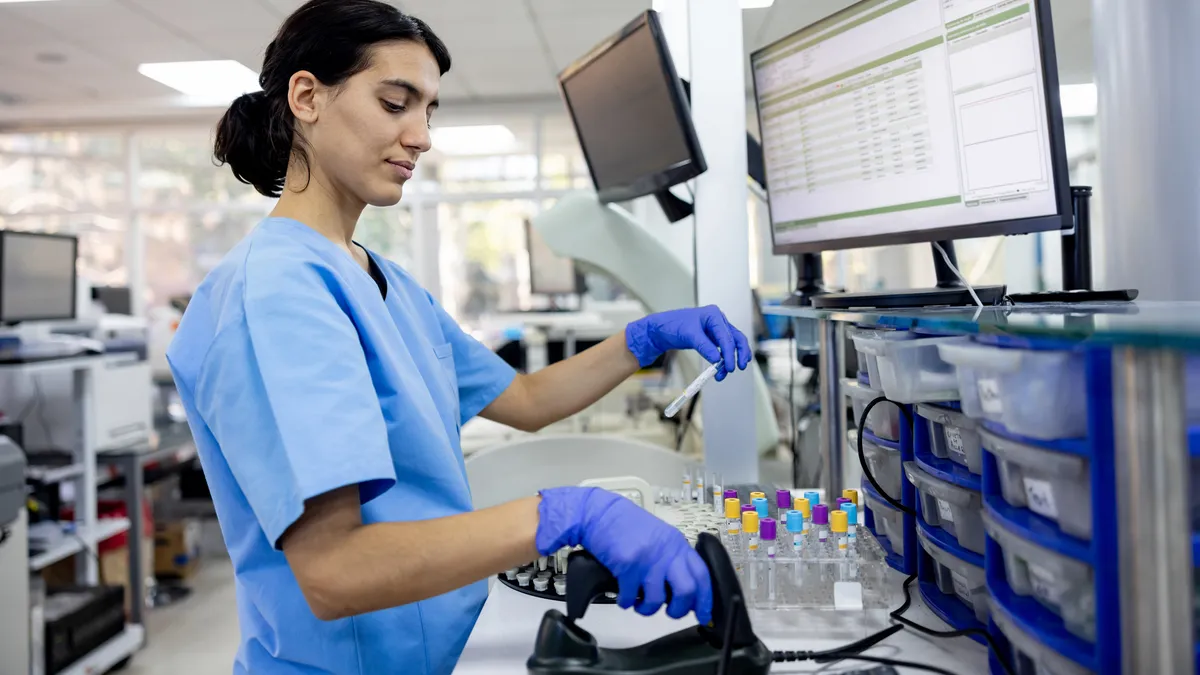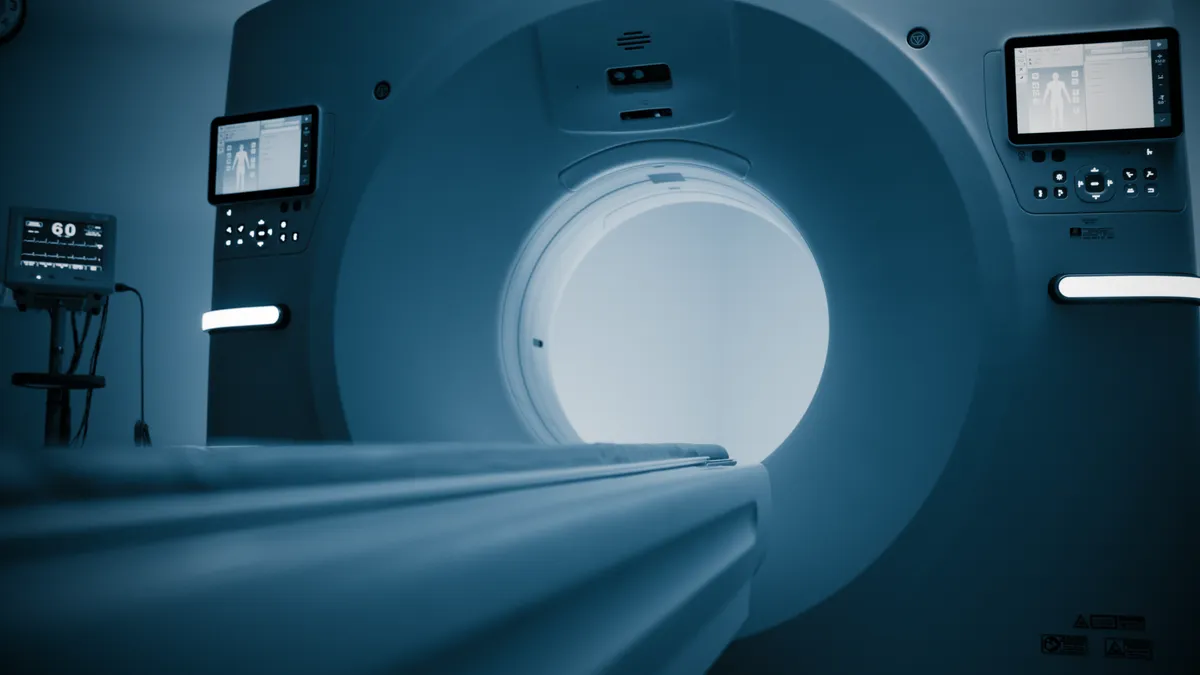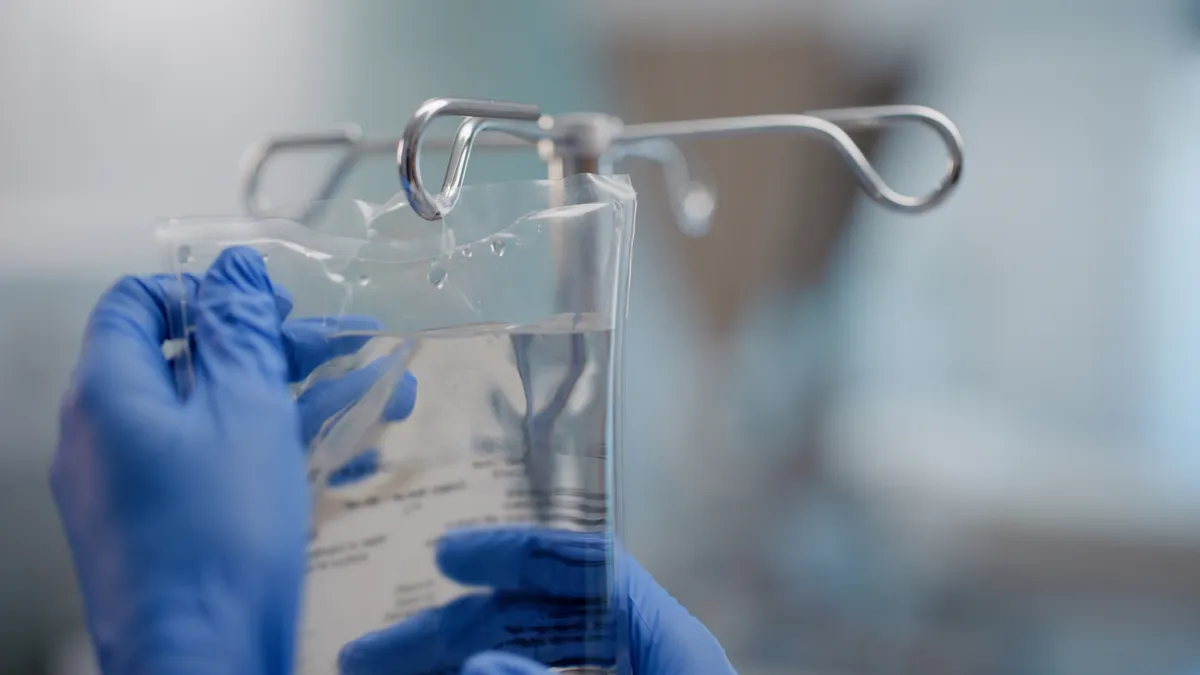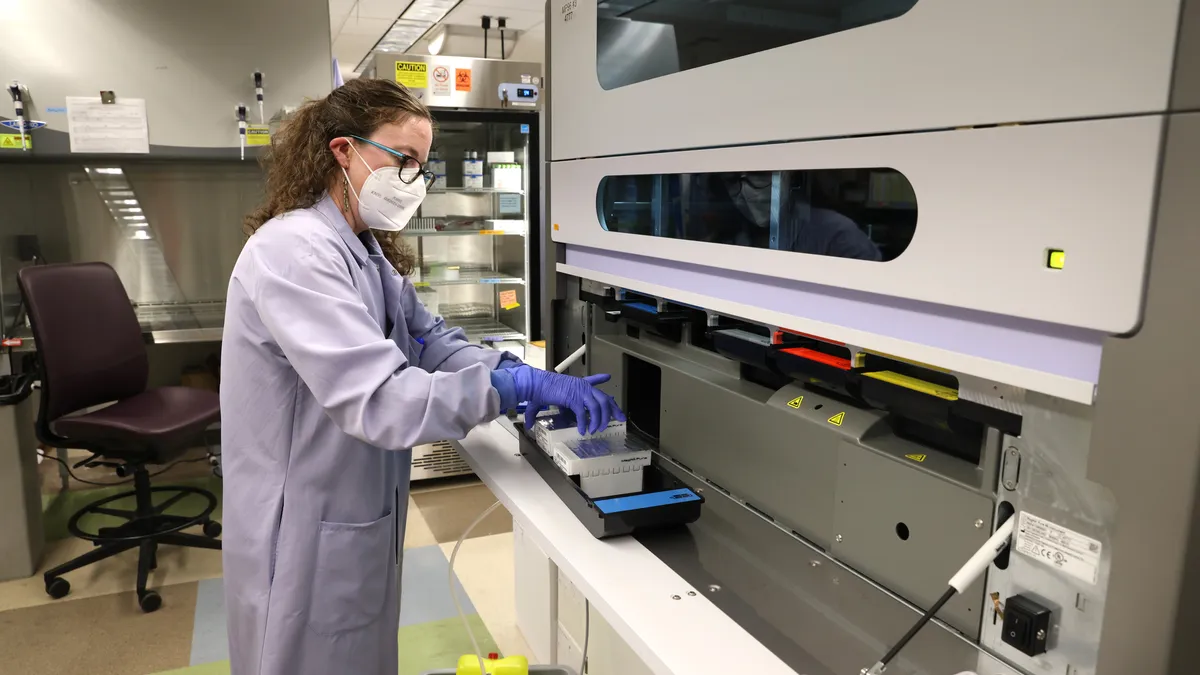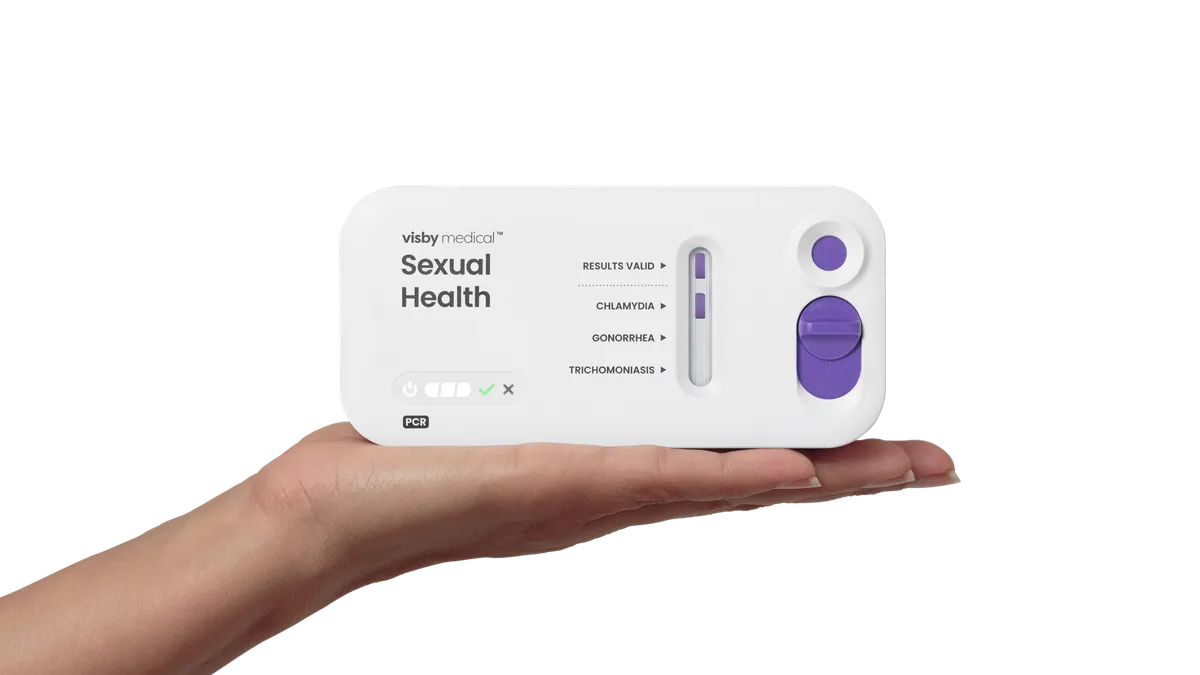Becton Dickinson, like other diagnostic companies, has seen “softened” demand for COVID-19 tests this year. The company brought in $76 million in revenue from testing of the virus in its fiscal third quarter, which was a decline of 75% from the same period in 2021. In total, BD’s life sciences division recorded $1.3 billion in revenue in the quarter, down 8.7% from the year-ago period. At the same time, the install base for its BD Max molecular testing platform has grown.
Dave Hickey, president of Becton Dickinson’s life sciences segment, talked about how the company is preparing a larger menu of tests for at-home use and for its molecular diagnostics systems, while managing COVID-19 and monkeypox testing.
(This interview has been edited for length and clarity.)
MEDTECH DIVE: In your last earnings call, you forecast a total of $500 million in COVID-19 testing for your 2022 fiscal year. What sort of demand are you seeing right now?
DAVE HICKEY: It's obviously softened since the height of the pandemic. I would say we are right in line to sort of hit what we've said will be our overall performance.
One of the things that we focused on very early on was having both molecular solutions on our BD Max lab-based platform as well as point-of-care solutions with the BD Veritor for both acute point-of-care facilities as well as at-home testing.
We've seen demand balanced across all of our testing types, but certainly as ‘22 has gone on, very consistent with what we’ve said, it's definitely softened in the second half of the year.
There’s been some discussion about antigen tests not being as sensitive with the omicron variant. Has that affected your business?
From the user's perspective, particularly the patient that's doing the self test or the at-home test, there's an assumption that the majority of these tests are fit for purpose.
We absolutely want to make sure that both our molecular tests and our point of care tests detect the latest variants. So from a performance perspective, all of our tests meet the minimum FDA performance thresholds.
What we also do just as a proactive measure — and this was true whether it was delta, whether it was omicron, whether it was BA.2 variant or BA.5 — we’re pretty proactive in doing what we call in-silico analysis, a simulated analysis of the test’s ability to detect the variants. When we're able to get a hold of live virus, we test the live virus itself, and make sure that we can detect all the variants. [With] everything that we've done, we have high confidence that all of the BD tests are detecting all the variants.
How are you balancing between COVID-19 testing and monkeypox testing?
We took a lot of our learnings from the way we responded to COVID by deploying that same level of response and intensity to monkeypox. So now obviously that is going to be on our molecular base platform.
In partnership with one of our assay development partners — a company called CerTest out of Europe — we’ve already developed and released a monkeypox research-use only assay outside of the United States. That will allow labs to do surveillance, tracking, etc., and perform testing.
If those labs themselves then take our research-use only assay and do their own internal validation studies, they can themselves certify it as a lab developed test and start to use it for diagnostic purposes.
For the United States, we are looking at basically two options. One is to deploy a research-use only method, but also given that the U.S. has declared a public health emergency, we're waiting to see — and there’s been some early dialogue from the FDA — whether they will also now enable or publish an emergency use authorization approach to monkeypox. Once those templates come out, we will absolutely be looking to respond just as we did with COVID.
[On Wednesday, after this interview, HHS Secretary Xavier Becerra signed a declaration to allow the FDA to issue emergency use authorizations to expand the availability of monkeypox tests].
As flu season approaches, how are you thinking about multiplex testing?
The availability of what we would call triplex tests or multiplex tests would be a huge benefit. Imagine being able to do a flu A, flu B, and a COVID test from a single sample on a single device. We already have that available on our BD Max molecular platform. Outside of the U.S., we also combine it with RSV, so we’ve got four assays in one. On the BD Veritor, we already have the triplex test available as well.
The one thing that we're working on right now is the development of a triplex test: flu A, flu B, and COVID for at-home use. That’s a high priority for us.
What considerations go into developing an at-home test?
We spend a lot of time on what we call user experience and preference testing. For example, when we first developed our at-home test for COVID, suddenly people can walk into CVS, they can go to Amazon. We wanted to be able to test or check, particularly for the users that had never done a test before, did I collect the sample correctly, and am I doing the right thing to report it?
So we wanted to make it as simple as possible, as error proof as possible, then take any of the subjectivity out of it. And honestly, that's why we made a very deliberate decision to actually move towards an application-based result to interpret rather than a visually read [result]. We also wanted to commit to the test-and-trace or test-and-treat programs.
We acquired Scanwell back in late 2021 as part of that digital architecture. As this migration of testing happens to point of care, we think having digital connectivity, even from at home into your electronic medical record is going to be critical.
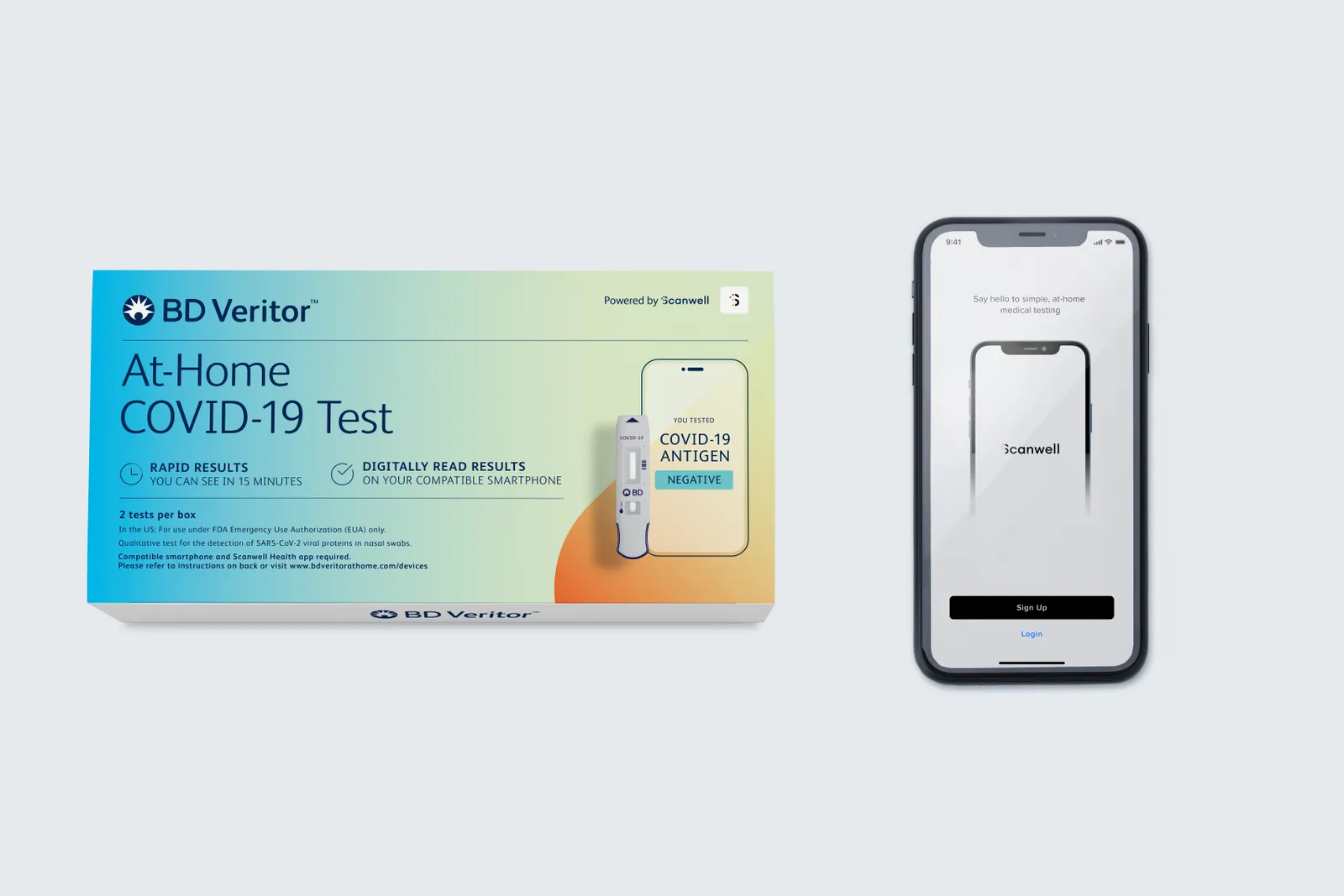
Do you have plans to develop other kinds of at-home tests?
We absolutely do. Obviously, these triplex tests are a high priority. But again, you see the potential, what if you could do RSV? What if you could do strep? There are clearly some infectious disease candidates, but also when you think about where the healthcare system has changed overall, look at hospitals wanting to do the virtual hospital or the hospital or home model. We also see the potential for non-infectious disease tests to be done at home. Tests that are more associated with chronic diseases and managing the chronic patient at home. We’ve not talked too much about that, what that roadmap will be, but we definitely see the potential.
With your molecular tests, and more customers with your BD Max system, what does that roadmap look like going forward?
It really is all about menu development. During COVID, the overall lab testing volume declined on routine testing as the labs switched to doing nothing but COVID testing. Labs are now back at normal volumes. But also they've now got platforms like the BD Max. Our BD Max install base grew 60% during the pandemic. So for us now it’s all about menu, menu, menu.
We work in disease states, so we work on things like healthcare acquired infections, enteric disease, sepsis, respiratory. We’re working on more molecular tests. What if you could develop these pan-coronavirus assays that could look at multiple variants and things like that? So we've got a very clear roadmap of what will go on to the menu.
A big focus for us, [and] as a trend in lab diagnostics overall, is the role of automation and connected devices. Because now that all of these labs have gotten back to full volume, I think as you see in the healthcare industry, staffing challenges and labor arbitrage is a real challenge. We know about it in the nursing shortages. That is equally true for labs, the lab techs. So we feel the role of automation, platforms like the BD Cor that we've just released in the US, the BD Kiestra for totally automating the microbiology lab, is going to be a critical part of one of these future trends, where labs will look to automate more of the testing process.








